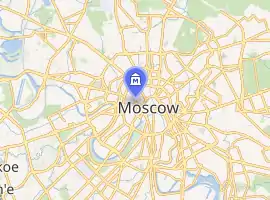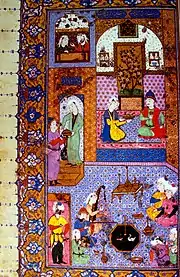State Museum of Oriental Art
The State Museum of Oriental Art (Russian: Музей Востока) is one of the biggest cultural institutions in the world for preservation, research, and display of Oriental art. The museum was founded in 1918 as a part of soviet programme to support unique cultures of USSR subdivisions. Since 1970 the museum is located in the centre of Moscow in the historical building known as the Lunins' House, a private residence built in the early 19th century by the famous architect Domenico Gilardi.[1]
 | |
 | |

| |
Former name | Ars Asiatica (1918—1925) |
|---|---|
| Established | 1918 |
| Location | Moscow, Russia |
| Type | Art museum |
| Website | Official website (English) |
The museum has galleries for the art and archaeology of India, Persia, China, Japan, Buryatia, Transcaucasia, and Chukchi Peninsula. Major part of the Persian objects have been donated by General Tardov in 1929.[2]
In 2017 the Nicholas Roerich Museum was established as a part of the State Museum of Oriental Art. Named after the prominent Russian artist Nicholas Roerich,[3] the new museum holds more than 800 masterpieces of Western painters from his collection and numerous items of decorative and applied arts, that Roerich family brought from India.[4][5]
History
Establishment
Before the October revolution Moscow had no centres of Oriental studies. When the independent republics were declared within the USSR, the government decided to establish a special museum for the East nations and their heritage. The project was developed by the Russian historian Pavel Muratov and supported by Igor Grabar, who was a leading art historian and a specialist in museum affairs. In a few months they opened ‘Ars Asiatica’, at first on the premises of the Russian State Historical Museum, then moved to Tsvetkov Mansion on Prechistenskaya Embankment.[2]
Fyodor Gogel became the museum's first director. Following the course of Korenizatsiya policy, the exposition was based on the art of the East Soviet nations. In 1925 the museum was renamed into ‘State Museum of Oriental Art’. Up to 1929, the organisation balanced on a verge of closure due to low scientific activity. However, in 1929 when the museum was moved to the former Church of Elijah at Vorontsovo Pole street, the personnel finally started full-scale works and research. The very first exhibitions opened in 1930, since then the museum received official governmental support.
Collection

The collection includes items from the National Museum Fund, antique shops, and nationalized private collections of noble families, taken by the government after the Revolution. In 1920s some items were transferred from the Polytechnic Museum, the Pushkin State Museum of Fine Arts, and the State Historical Museum.[6]
The major part of the collection was donated by private philanthropists. For example, Pyotr Shchukin had a keen interest in Oriental art and gathered a solid collection of old master prints and figurines from China, Iran, and India. In 1910 he established a private museum at Malaya Gruzinskaya street. After the Revolution, it was nationalized and given to the Museum of Oriental Art.[7] The museum also received private collections of Pavel Kharitonenko, perfumer Henri Brocard, Orientalist Alexey Pozndeev, Nikolay Mosolov, and Igor Grabar.[6]
The first permanent exhibition was opened in 1919 at the Russian History Museum and included arts from China, Japan and Iran. Since 1924 the museum launched several expeditions to the Far East in order to collect new artifacts. By order of the Soviet government, from 1930 the exhibitions included propaganda materials.
In 1926-1928 the second director Boris Deneke launched three expeditions to Old Termez. They provided the museum with unique items from the XII century palace and other historical sites. In 1929 the first buying expeditions were sent to Kurdistan and Tusheti.
Contemporary Activities
Nowadays new valuable items keep coming to the museum's vast collection through private donations and archaeological excavations.[8] As of 2018, the collection includes more than 160,000 artefacts: paintings, graphics, sculpture, clothing, arms, and domestic items. Apart from its permanent exhibitions, the museum manages and co-creates various activities and events with other cultural organizations.[9][10]
References
- "Museum of Oriental Art website in English".
- "Государственный музей искусства народов Востока" [State Museum of Oriental Art] (in Russian). Culture.ru. Retrieved 2020-01-29.
- Madhukar, J. (2019-10-20). "Remembering Roerich". ‘The Bangalore Mirror’. Retrieved 2020-01-29.
- Holdsworth, N. (2017-05-03). "How an art museum in Russia became the target of Kremlin police raids". The Christian Science Monitor. Retrieved 2020-01-29.
- "Музей Рерихов" [The Roerich Museum] (in Russian). Culture.ru. Retrieved 2020-01-29.
- Shulepova 2010.
- "Celebrating the Genius of Sergei Shchukin: The Pushkin Museum of Fine Arts pays tribute to a great collector". The Moscow Times. 2019-07-23. Retrieved 2020-01-29.
- "Manuscripts of Sufi sheikh presented at Museum of Oriental Art". ‘Vestnik Kavkaza’ Magazine. 2020-01-31. Retrieved 2020-01-29.
- Petir Garda Bhwana (2019-11-05). "Russia's Warm Gamelan Night at the Museum". Tempo English Magazine. Retrieved 2020-01-29.
- "Echo of Soviet Azerbaijan in State Museum of Oriental Art" (in Russian). ‘Vestnik Kavkaza’ Magazine. 2020-02-06. Retrieved 2020-01-29.
Sources
- Shulepova, E. A. (2010). Музееведческая мысль в России XVIII-XX веков [Museology in Russia in XVIII-XX Centuries] (in Russian). Moscow.
| Wikimedia Commons has media related to State Museum of Oriental Art. |
| Wikimedia Commons has media related to Lunin's house (Nikitsky Boulevard). |